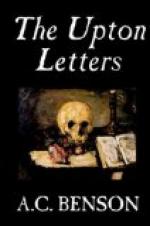But I must not end thus. I came home; I told my tale; I found my friend returned. He nodded gravely and wonderingly, and I think he half understood. But his wife was full of curiosity. She made me tell and retell the incident. “Was there no one you could ask?” she said; “I would not have rested till I had solved it.” She even bade me tell her the name of the place, but I refused. “Do you mean to say you don’t want to know?” she said. “No,” I said; “I had rather not know.” To which, rather petulantly, she said, “Oh, you men!” That evening a neighbouring parson, his wife, and daughter, came to dine. I was bidden to tell my story again, and the same scene was re-enacted. “Was there no one you could find to ask?” said the girl. I laughed and said, “I daresay I could have found some one, but I did not want to know. I had rather have my little mystery,” I added; and then we men interchanged a nod, while the women looked sharply at each other. “Is it not quite incredible?” my friend’s wife said. And the daughter added, “I, for one, will not rest till I have discovered.”
That, I suppose, is the difference between the masculine and the feminine mind. You will understand me; but read the story to your wife and daughters, and they will say, “Was there no one he could have asked?” and “I would not rest till I had discovered.” Meanwhile I only hope that my maiden’s efforts will prove unavailing.—Ever yours,
T. B.
GREENHOWE,
SEDBERGH,
Aug. 21, 1904.
My dear Herbert,—I suppose I am very early Victorian in my tastes; but I have just been reading Jane Eyre again with intense satisfaction. (I will tell you presently why I have been reading it.) I read it first as a boy at Eton, and I must have read it twenty times since. I know that much of it is grotesque, but it seems to me that its grotesqueness is not absurd, any more than the stiff animals and trees or hills in the early Italian pictures are absurd; one smiles, not contemptuously, but tenderly at it all.
Again, there are two ways of treating a work of art. If a portrait, for instance, is intensely realistic and true to its original, one says, “How lifelike!” If it is widely unlike the original, one can always say, “How symbolical!” Of the first kind of portrait one may say that it brings the man before you; of the latter you may say that the artist has striven to paint the soul rather than the body. Well, I think it is fair to call Jane Eyre symbolical. Some of the people depicted are very true to life. The old, comfortable, good-humoured housekeeper, Mrs. Fairfax; Bessie the nursemaid; Adele, the little French girl, Mr. Rochester’s ward; the two Rivers sisters—they are admirable portraits. But Mr. Rochester, the haughty Baroness Ingram of Ingram Park, Miss Ingram, who says to the footman, “Leave that chatter, blockhead, and do my bidding,” St. John Rivers, the blue-eyed fanatic—these




